ISSN 2348-1196 (print)
International Journal of Computer Science and Information Technology Research ISSN 2348-120X (online) Vol. 8, Issue 3, pp: (131-146), Month: July - September 2020, Available at: www.researchpublish.com

ISSN 2348-1196 (print)
International Journal of Computer Science and Information Technology Research ISSN 2348-120X (online) Vol. 8, Issue 3, pp: (131-146), Month: July - September 2020, Available at: www.researchpublish.com
1 Nurul Syakilah binti Noorhamidi, 2 Yusrina binti Mohd Yusri, 3 Suzanna binti Zulkifli, 4 Abdul Rahman bin Ahmad Dahlan
1 Department of Computer Science, 2,3,4 Department of Information Technology 1,2,3,4 Kulliyyah of Information and Communication Technology, International Islamic University Malaysia
Abstract: The objective of this paper is to reintroduce a business model canvas for a food delivery platform that is aligned to the United Nations Sustainable Development Goals (SDG). The platform harnesses the rapid advancement of the Industrial Revolution 4.0 (IR) technology as well as human adaptation towards technology infrastructure and digital capabilities in the food delivery business. This paper identified several key problems and pains of the Customer Segments in the current food delivery system business model that ought to be solved. The key problems include the lack of diversification of halal foods in non-Muslim countries (SDG 2), unemployment issue (SDG 4&8) and poverty among the Muslim community (SDG 1). The methodologies used in this paper is design thinking methodology. The methodology is carried out by using business modelling tools which are Literature Review, Business Model Canvas (BMC), strategy canvas (SC), Value Proposition Design Canvas (VPC), Environmental Map, future work, and Business Plan. From the validation of the BMC and VPC presented in the paper, the key findings are HalalFoodies business model and app can help them to ease the finding of halal food while traveling to non-Muslim countries, users also have the ability to perform sadaqah through our app to help needy people and perform the sunnah, and that the platform offers job opportunities to the community. The conceptual business model for this paper includes an enhanced Business Model Canvas that encompasses additional customer segments which are the B40 group of citizens, and the Non-Government Organizations (NGOs).
Keywords: Business Model Canvas; Strategy Canvas; Value Proposition Design Canvas; Halal Food, Delivery; Sustainable Development Goals, SDGs.
The concept of food delivery was initially introduced to open more job opportunities, apart from offering a service to deliver food without the hassle of queuing up in a long line to buy food. The service was geared towards tertiary education students, workaholics parents, and professional workers as these groups of users have little to no time to spare for cooking at home [1]. However, the current business model canvas of food delivery service is not exclusive to Muslim travelers and/or Halal food delivery service [2][5]. Therefore, this paper discusses and outlines the gains and benefits for the business model canvas remodeling for the Muslims and Halal food industry and service.
The technology plays a major role in the global food industry and global supply chain management. Technology addresses operational efficiencies and quality improvement in daily supply chain activities while simultaneously capturing data for real-time and later-time analytics that are influential to decision making for the business [3]. Augmented reality (AR), process automation, data warehousing, and e-commerce sites help businesses grow and keep track of the
ISSN 2348-1196 (print)
International Journal of Computer Science and Information Technology Research ISSN 2348-120X (online) Vol. 8, Issue 3, pp: (131-146), Month: July - September 2020, Available at: www.researchpublish.com
megatrends as well as to cater for consumer’s requirements [3]. With the reconstruction of the way the industry handles the supply chain management, business players can modify their business model(s) to suit their business well. To achieve the goals and objectives of the project, the nine components that exist in the business model canvas must be revised. This is crucial to identify the relevance of the existing key players, key activities, revenue streams, and cost structure, as well as to include additional components into respective categories in the BMC. In addition to that, a series of design thinking methodologies are to be carried out to remodel the business model and improvise the current food delivery business. The pains identified for various customer segments in the BMC includes the difficulty to look for restaurants that offer halal foods overseas, the ambiguous halal status of the food, tedious payment methods, less customer attractions to the restaurants, poor marketing, poverty among the Muslim communities, and lack of donation streams from the NGOs [4][5].
The exclusivity of Halal food industry service is significant to the Muslim community. Without this exclusivity, the quality and/or the guarantee that the food is halal becomes ambiguous and travelling to non-Muslim countries becomes an issue. The major issues faced by customer segments in this business model canvas are the lack of diversification of halal foods in non-Muslim countries, unemployment issue, and poverty among the Muslim community [3][4][5][6]. Ambiguous status of the food makes it harder for Muslims to look for food while travelling overseas, especially the nonMuslim countries. Furthermore, unemployment and poverty among the Muslim communities are continuous issues that need to be overcome at full tilt. There are various new opportunities to be discovered from this project. One prominent opportunity is the inclusion of halal food in the non-Muslim countries. Moreover, new job opportunities will be open to the public and this would eventually help the government to tackle unemployment issues, and indirectly solve poverty issues through the donation streams enabled in the business model and key activities.
This paper adopts the design thinking methodology. The Design Thinking methodology is adapted for this paper which is to understand the key problems, ideation of possible solution options, validation of options by customer segments, and to suggest a conceptual solution. This includes conducting literature review and benchmarking, conducting interviews using the business modeling tools such as the nine blocks of Business Model Canvas (BMC), Value Proposition Canvas (VPC), Environment Map (EM), and Strategy Canvas The initial BMC is validated by interviewing the customer segments which are the buyer, seller, and the app users. In addition to that, the initial VPC is validated by interviewing various customer segments to clarify the pains and gains of each subject.
1) Market forces: The food industry is a major key player in sustaining a thriving nation. A business that caters for the essentials has a higher chance of sustainability as the demands for the supplies and/or products will always remain relevant to the industry [4][5][6].
2) Key trends: In this era, we are provided with efficient and reliable connectivity and communication services through personal computers and smartphones. Through this connectivity, the communication between businesses and the consumers [3].
3) Industry forces: HalalFoodies has a lot of potential to penetrate into the international industry forces given that it brings exclusivity into the industry abroad [5].
4) Microeconomic forces: practicing Muslims are very cautious in picking the foods for consumption. Therefore, with the exclusivity of the Halal food industry, the community is equipped with the right platform that will ease their worry while travelling to non-Muslim countries [5].
The Business Model Canvas is being used as a tool for a strategic management and lean start up template to develop and remodel new and existing business models. It narrates nine (9) blocks of Business Model Canvas framework which are Customer Segment, Customer Relationship, Channel, Value Proposition, Key Activities, Key Resources, Key Partners, Cost Structure, and Revenue. [8]
ISSN 2348-1196 (print)
International Journal of Computer Science and Information Technology Research ISSN 2348-120X (online) Vol. 8, Issue 3, pp: (131-146), Month: July - September 2020, Available at: www.researchpublish.com
The Value Proposition Design Canvas is being used to identify customer Gains and Pains to be able to lay out Gain Creator and Pain Reliever. [9]
Strategic planning and management are essential in this business to compete with the current industry and market forces. Thus, the business will apply digital trends and industrial revolution technologies, as well as the global Sustainable Development Goals in its business activities and management. In this Strategy Canvas, HalalFoodies will lay out possible strategies to outplay the other major key business players in the industry [3].
To identify the gaps and loopholes in the current food delivery service, we conduct an in-depth review of existing web and mobile applications. The purpose of literature review is to summarize and synthesize existing arguments and ideas without adding new contributions to emphasize the key findings and importance of the topic [10]. The applications being reviewed are BungkusIt, and DahMakan.
Interviews and surveys will be conducted to identify and spot the criteria required by consumers in using the HalalFoodies application.
Benchmarking is a tool used in this paper to measure up the quality, time, and cost involved to develop this HalalFoodies application. The benchmarking process includes comparing processes and performance metrics to industry levels and best practices from other companies.
Literature review is an essential element in developing HalalFoodies. It helps us to identify possible features and functionality that can be enhanced and be adapted from current products. On the other hand, the result from diversified research can help us in identifying strengths and weaknesses that already exist. Besides, this research will help us to prevent any errors that might happen during development as well as providing alternative and future potential strengths. Therefore, literature review will initiate new and fresh ideas on the features and functionalities that can be implemented for the proposed application.
Picture 1: The web interface for BungkusIt
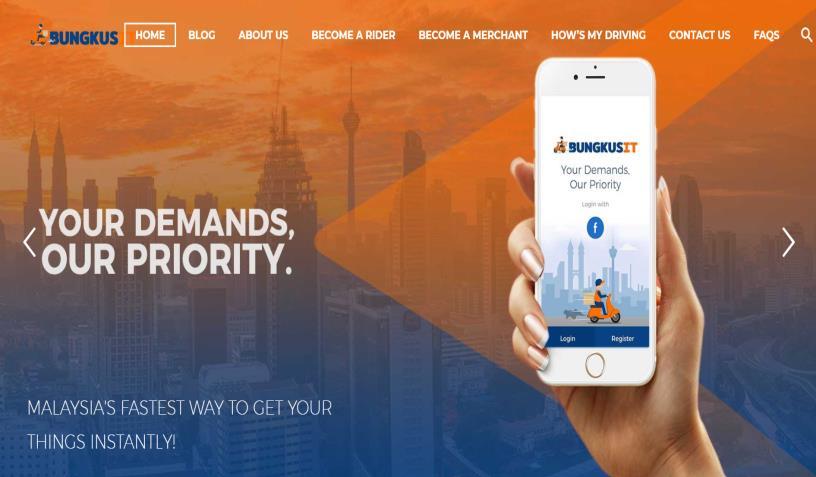
ISSN 2348-1196 (print)
International Journal of Computer Science and Information Technology Research ISSN 2348-120X (online) Vol. 8, Issue 3, pp: (131-146), Month: July - September 2020, Available at: www.researchpublish.com
Picture 2: The mobile interface for BungkusIt
BungkusIt is an On-Demand delivery app for Android & Ios which helps to run customers’ daily tasks.[11] They provide services such as posting parcels, buying last-minute gifts, food delivery and the list goes on. Besides, they are hyperlocal that aim to provide jobs and income for B40s and help SMEs by breaking the digital barrier. They also have 500km radius delivery which customers can order from far away. BungkusIt charges 0% commission to all SMEs thus making them the cheapest one of the cheapest food delivery applications. However, since this application is still new, their app UI is still being improved.
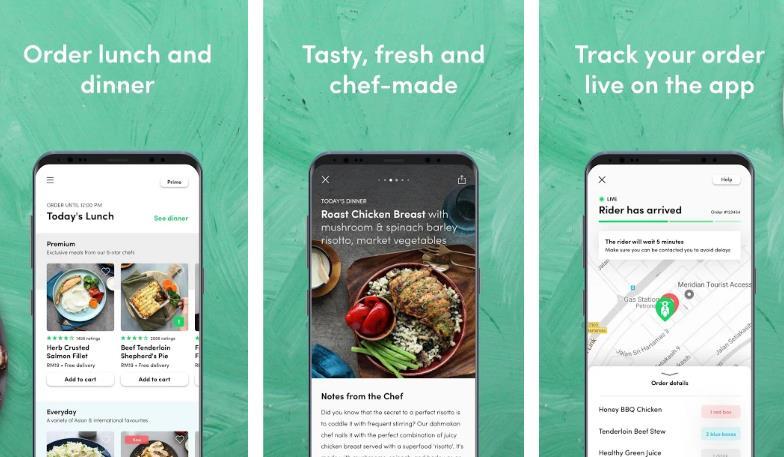
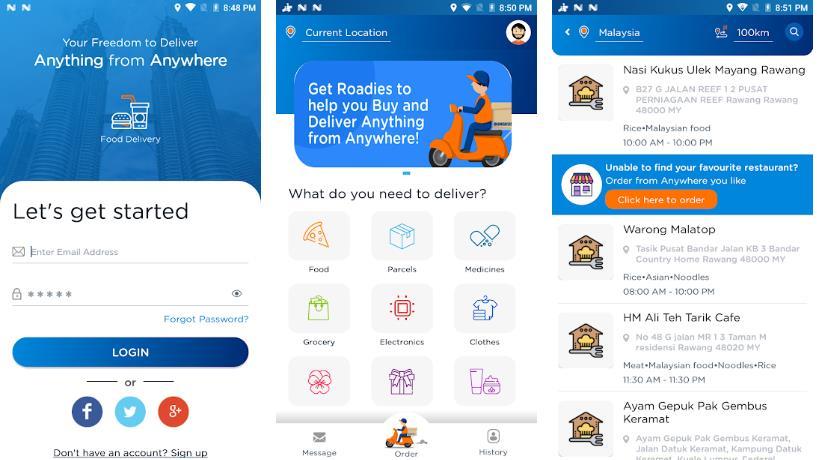
Picture 3: The web interface for dahmakan
Picture 4: The mobile interface for dahmakan
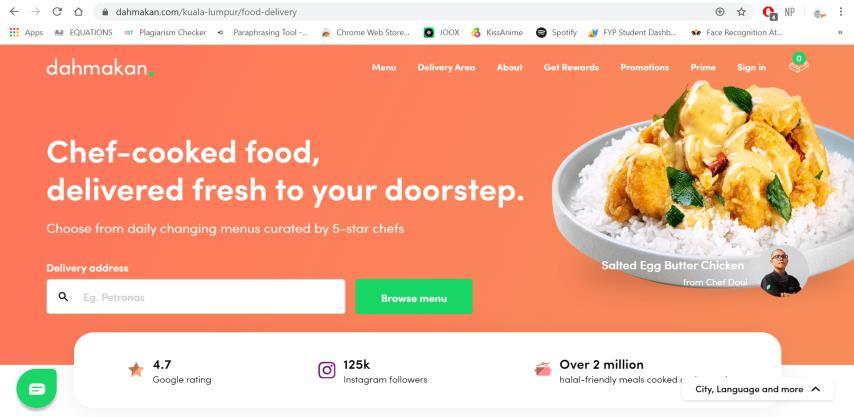
ISSN 2348-1196 (print)
International Journal of Computer Science and Information Technology Research ISSN 2348-120X (online) Vol. 8, Issue 3, pp: (131-146), Month: July - September 2020, Available at: www.researchpublish.com
If there’s one thing that Dahmakan is known for, it’s their home-cooked style food that’s made by 5-star chefs [12] Serving both lunch and dinner, customers can choose from their menu which offers cuisines from local to western palates. It has the lowest food delivery application as well.
Benchmarking is essential when starting up a new business to measure the quality, time and cost in developing a product. To produce the best end product, we are comparing processes and performance metrics to industry bests and best practices from other similar companies that will help us to improve the performances of HalalFoodies. Below is the example of related applications to be considered as benchmark:
One of the biggest and most famous applications today, Grab ventured to Grabfood only recently. However, with their funding they were able to spread through fast. Famous for Grab e-hailing, they could easily venture into food with their infrastructure built up in Malaysia [13]. They also provide services such as GrabMart, GarbExpress, GrabInsurance and
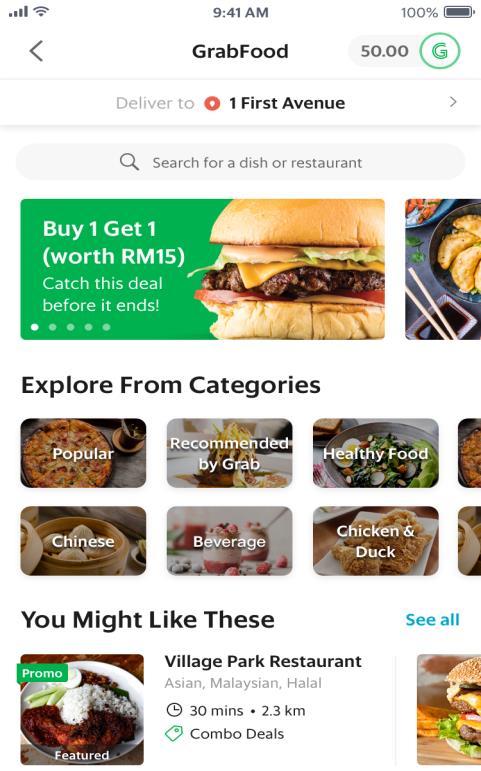
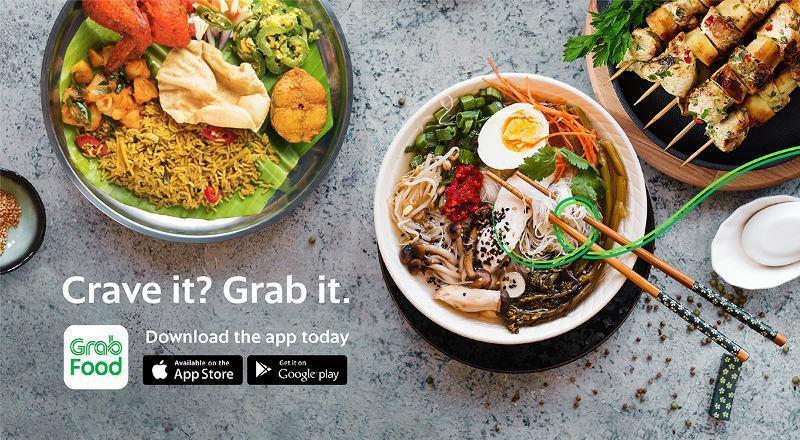
ISSN 2348-1196 (print)
International Journal of Computer Science and Information Technology Research ISSN 2348-120X (online) Vol. 8, Issue 3, pp: (131-146), Month: July - September 2020, Available at: www.researchpublish.com
lots more. Recently, even during pandemic in conjunction with Covid-19, they are considered as frontlines as they still deliver food.
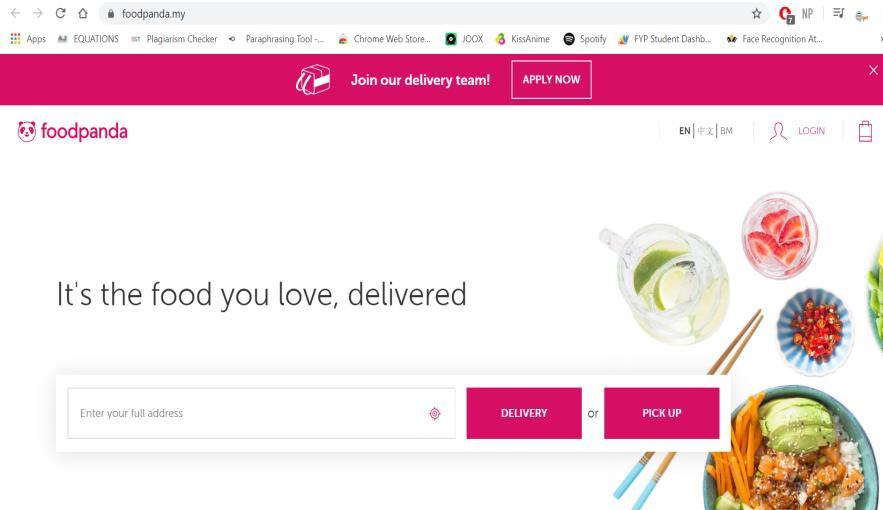
Foodpanda was one of the first to start in Malaysia for food delivery. They do not have as many services as Grab, however, since they emphasize more on food delivery, their service is better. so, more towards high end restaurants and big chain outlets [14]. They have always been aggressive with their promotions and price cuts. Food Panda comes with a lot of choices in application and they have website ordering as well for corporate companies. Indeed, FoodPanda is considered a benchmark for this project since they have a feature specially for halal foods in Malaysia.
Four Lenses of Innovation was introduced by Rowan Gibson [15] as a power tool of creativity. With this framework, we could learn the formula for infusing creativity into our organization. Four Lenses of Innovation consists of four main aspects which are Challenging the Orthodoxies, Harnessing Trends, Leveraging Resources and Understanding Needs.
For HalalFoodies, challenging orthodoxies give us an overview on how we can get more customers and how to compete with other successful companies. HalalFoodies comes with a strategy where it wants people to feel the easiness in using the application by using simple features yet attractive interfaces. HalalFoodies tries to challenge the conventional practices by common food delivery applications such as FoodPanda and Grabfood where they need take a longer time in browsing for halal foods. Hence, HalalFoodies will provide uniqueness of delivering Muslims halal foods that will decrease the distress faced by Muslims when halal food is unavailable.
HalalFoodies is harnessing the trends by aiming a better solution that will help ease Muslim customers who wants a halal food when halal food is not available around them. However, HalalFoodies is not just for Muslims for all customers despite different beliefs and religions.
From the leveraging resources perspective, HalalFoodies application main targets are Muslims all over the world, runners, media and individual workers. Since HalalFoodies is a conceptual solution, it has a future picture of acting as a medium to solve the solution to their problems in finding halal foods and providing jobs for unemployed individuals. It is still not operational. Thus, it could not be leveraged at this point.
ISSN 2348-1196 (print)
International Journal of Computer Science and Information Technology Research ISSN 2348-120X (online) Vol. 8, Issue 3, pp: (131-146), Month: July - September 2020, Available at: www.researchpublish.com
With the need to understand people's precious time, HalalFoodies will reduce their burden and save their time by delivering their orders on time. More often, it’s not the driver’s fault if a delivery takes more time. The complexities emerge at the point when a devoted system and good communication between restaurants and delivery system providers has not been established. Because of this absence it leads to complications in predicting order times for consumers and thus unmet expectations when the order takes longer than expected. Besides, not all countries' restaurants provide a halal certificate food, thus the food delivery demand is going largely unmet.
Megatrend is defined as global, sustained and macro-economic forces of development that impacts business, economy, society, cultures and personal lives thereby defining our future world and its increasing pace of change.[16][18]
One of the drivers for megatrends is technological breakthrough. In this era, we are in the midst of a fourth industrial revolution, or also known as digital revolution, where rapid advancement in technologies take place. For example, the enhancement of artificial intelligence, machine learning and big data are indeed at the center of all megatrends.
60% of all occupations could see at least 30% of their component activities automated [17]. Most human jobs can be done by machines and with the enhancement of artificial intelligence takes place, human expertise can now be learned and mastered by a system. Besides, these days, people are connecting with each other only by using the internet. A lot of mobile applications have been developed to ease humans. Most mobile applications have their own functions and features such as Grab where it helps users to travel from one place to another. Grab has the services of food delivery too to ease and satisfies food cravings.
A. Market Forces:
De Reu (2019) states that, “people are very specific when they are searching for food, and they are looking to find it fast” (p.1) [18]. This shows that minimum time of delivery and fast searching is important for customers' experience. Thus, our application should serve an easy halal food search by comparing different types of food and giving the fastest food delivery.
According to Oza (2019), “mobile application helps in creating a direct marketing channel between businesses and their customers, allowing for direct and effective communication” (p.1) [19]. Hence, mobile application platforms are used by HalalFoodies to connect with their customers.
Food-service becomes prominent during pandemic time. This is because of the current situation where everyone has to practice social distancing and follow the restricted movement order. Even before this tragic event, food-service is one of the services that create revolution for the food industry. Ramanee (n.d.) highlights that, “Consumer-based industries including the food-service sector, have been expanding their reach via digital platforms in the last few years. Delivery platforms like Foodpanda and Grabfood lent a new dimension to service, thanks to rapid lifestyle changes” (p. 1) [20]. This shows that the new norms and lifestyles changes forces food-services such as HalalFoodies to commercialize more to suit the current need of people.
D.
According to Khurana (2019), “There are limitations to the amount of information that can be displayed in a physical store. It is difficult to equip employees to respond to customers who require information across product lines. Ecommerce websites can make additional information easily available to customers. Most of this information is provided by vendors and does not cost anything to create or maintain.” (p.1) [21]. This shows that the use of online platforms can help businesses to commercialize more of their products. Thus, HalalFoodies serves a good place for restaurant owners to promote their products and communicate with their customers.
ISSN 2348-1196 (print)
International Journal of Computer Science and Information Technology Research ISSN 2348-120X (online) Vol. 8, Issue 3, pp: (131-146), Month: July - September 2020, Available at: www.researchpublish.com
The strategy canvas is used to compare HalalFoodies with other key players in the market. Through this way, knowledge can be developed to help build a successful strategy for HalalFoodies.
In this strategy canvas also, we would like to develop an application that contributes values for human and environments. This can be achieved by easing the customers’ pains. We want to create an application that ease the finding of halal food in non-Muslim country, gives lower minimum time of food delivery delays and easy payments for user satisfaction. Moreover, we would like to help to improve the environment's health and support government initiative in Sustainable Development Goals by using biodegradable products for our food containers.
In addition, digital marketing is a crucial medium to engage users in this step of strategy. Then the main aspect that we should focus on is social media. This is because social platforms help to communicate with our users or buyers, raise awareness of our brand, and increase advertising and profits. With more than three billion people around the world using social media every month, it is reasonable to use this approach as part of our strategy.
HalalFoodies also focuses on helping needy people by creating a donation platform for users to perform sadaqah and also helping the existing non-government organizations that support the welfare of needy people by gaining money from our application.
Figure A below shows the initial business model canvas that has been created.
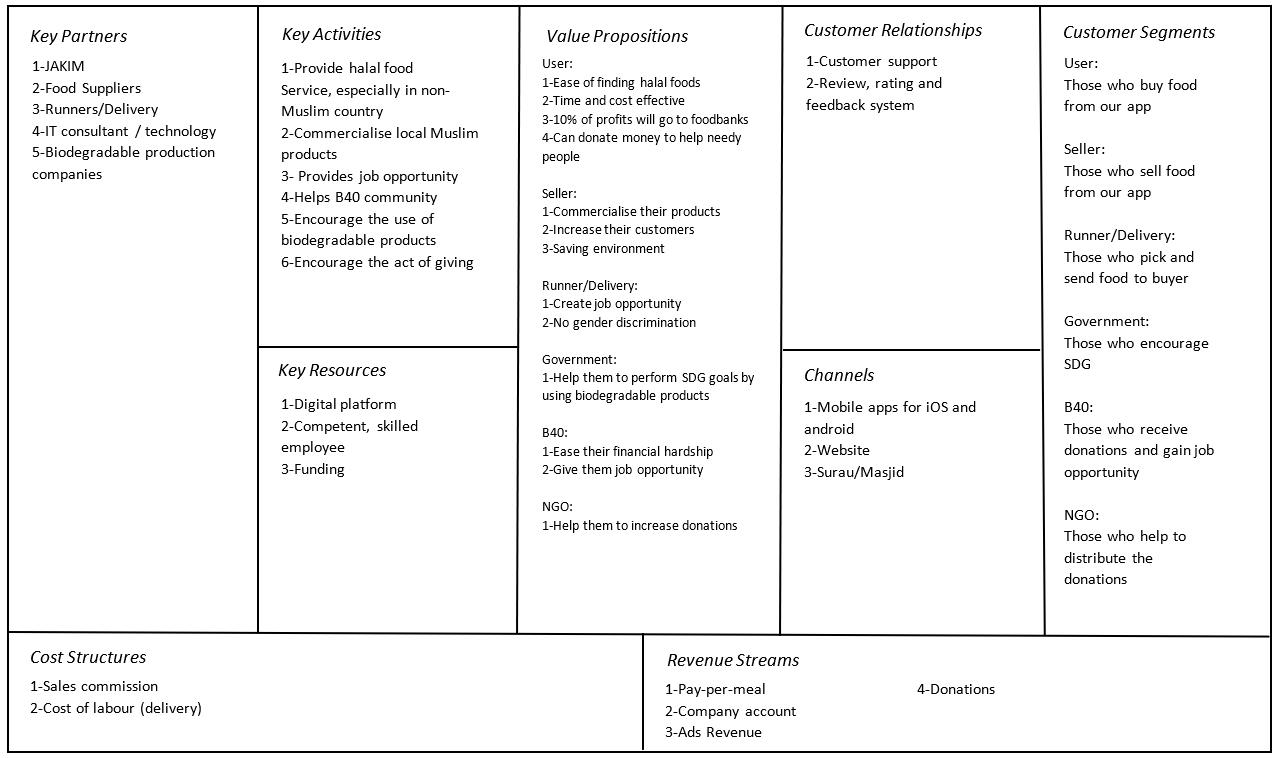
Figure A: Initial Business Model Canvas HalalFoodies
The initial Value Proposition Canvas was developed after recognition of the customer's needs and problems. This Value Proposition Canvas is used to establish the value of HalalFoodies for buyer, seller and runner. A value proposition also may be viewed as a promotional or marketing message that a corporation uses to explain why a customer should buy a product or use a service. Figures below show the value proposition canvas for HalalFoodies.
ISSN 2348-1196 (print)
International Journal of Computer Science and Information Technology Research ISSN 2348-120X (online) Vol. 8, Issue 3, pp: (131-146), Month: July - September 2020, Available at: www.researchpublish.com
Figure 1: Value Proposition for Buyer
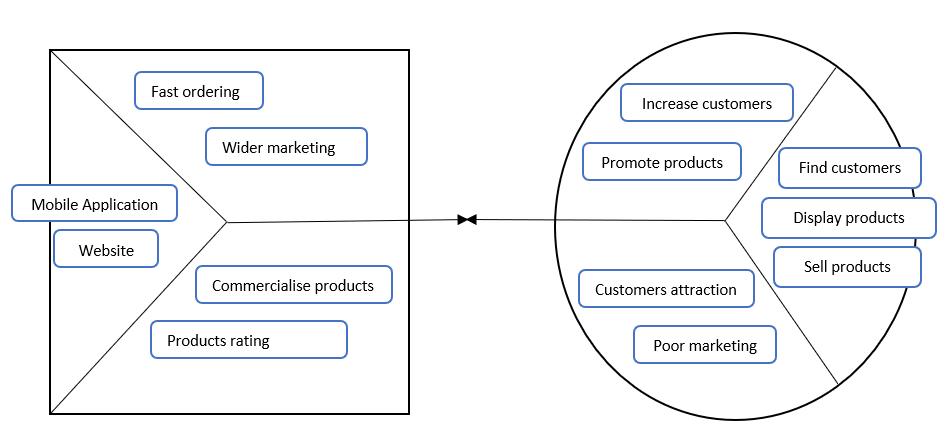
Figure 2: Value Proposition for Seller
Figure 3: Value Proposition for Driver or Delivery
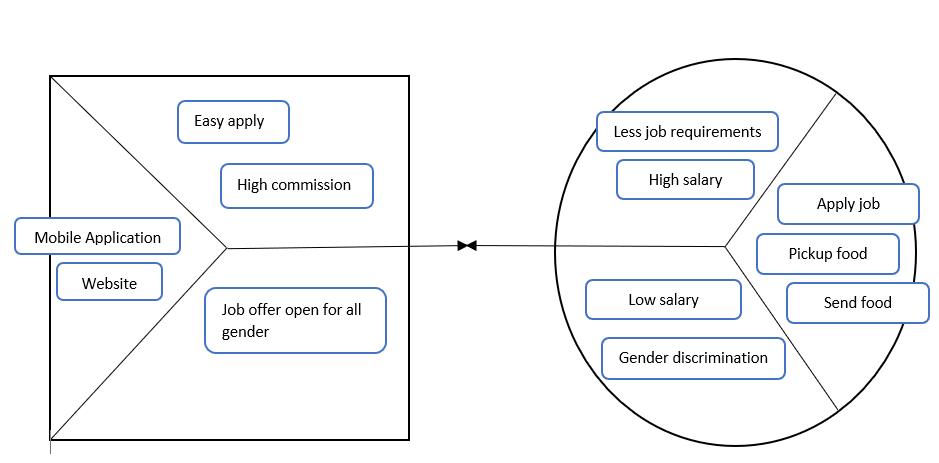
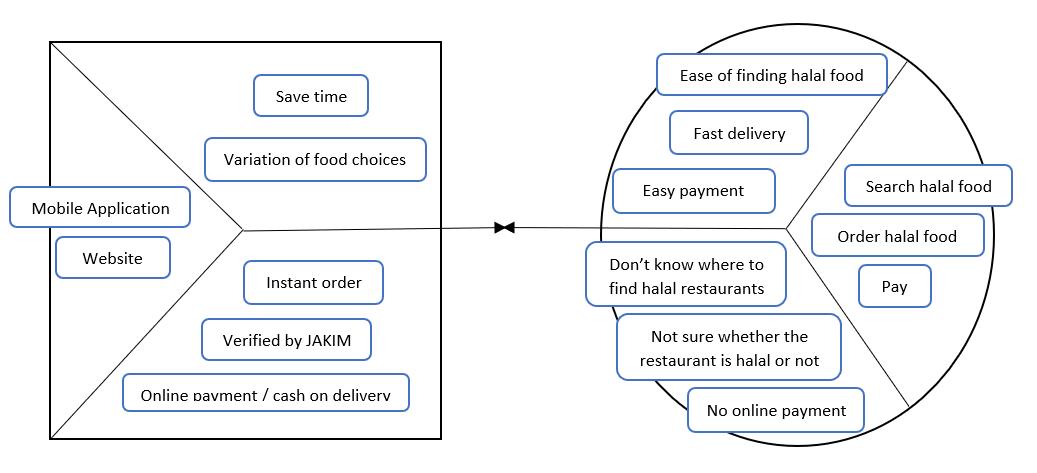
ISSN 2348-1196 (print)
International Journal of Computer Science and Information Technology Research ISSN 2348-120X (online) Vol. 8, Issue 3, pp: (131-146), Month: July - September 2020, Available at: www.researchpublish.com
Figure 4: Value Proposition for Government
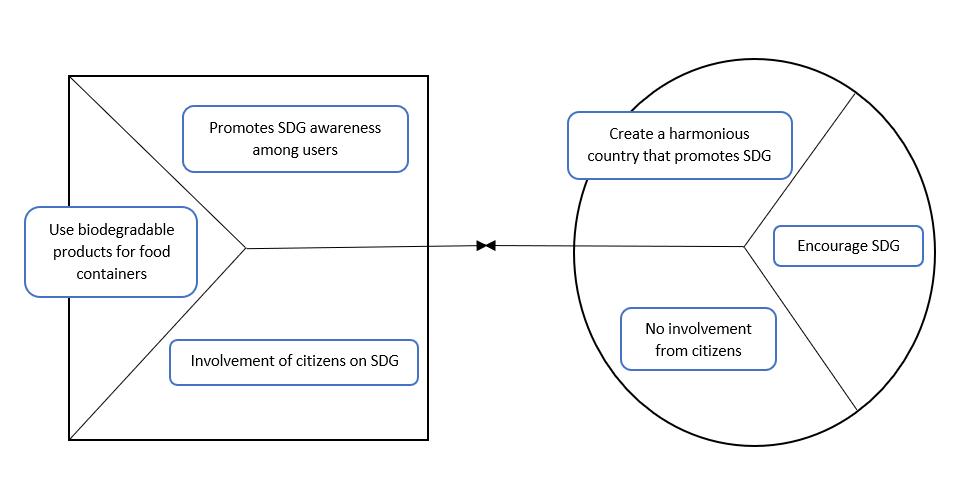
Figure 5: Value Proposition for B40 people
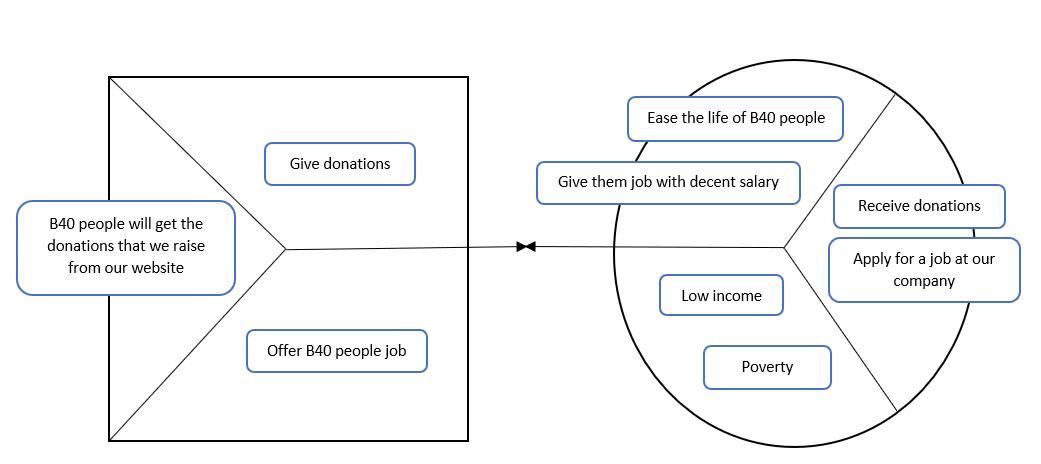
Figure 6: Value Proposition for Non-Government Organization
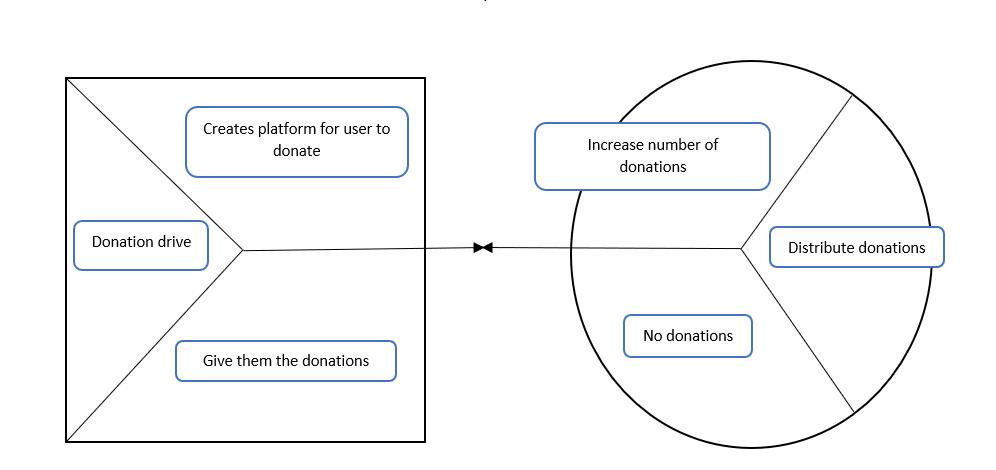
ISSN 2348-1196 (print)
International Journal of Computer Science and Information Technology Research ISSN 2348-120X (online) Vol. 8, Issue 3, pp: (131-146), Month: July - September 2020, Available at: www.researchpublish.com
Validation for HalalFodies initial business model canvas has been conducted through an online survey. There were seven questions for the user to answer in order to validate our business plan. The first question was to ask the users whether they have been traveling to any non-Muslim country. 93% of them said that they have traveled to non-Muslim countries and 6.7% of them said no. Pie chart 1 below shows the number of people that have travelled to any non-Muslim countries.
Pie chart 1: The number of people travelled to any non-Muslim countries
The second question was to ask the users whether they have problems in finding halal food in non-Muslim countries. Result showed that 95.7% from the total of people said that they have problems in finding halal food in non-Muslim countries. While the rest 3.3% of people said they are not having any problems. Pie chart 2 below shows the result for this question.
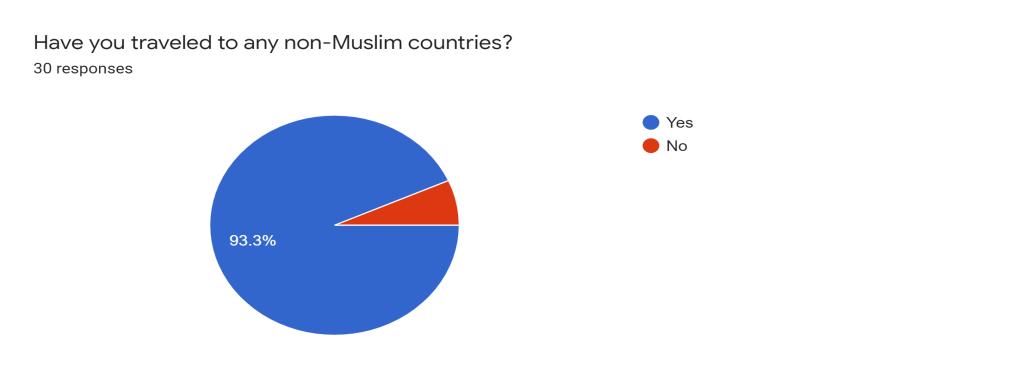
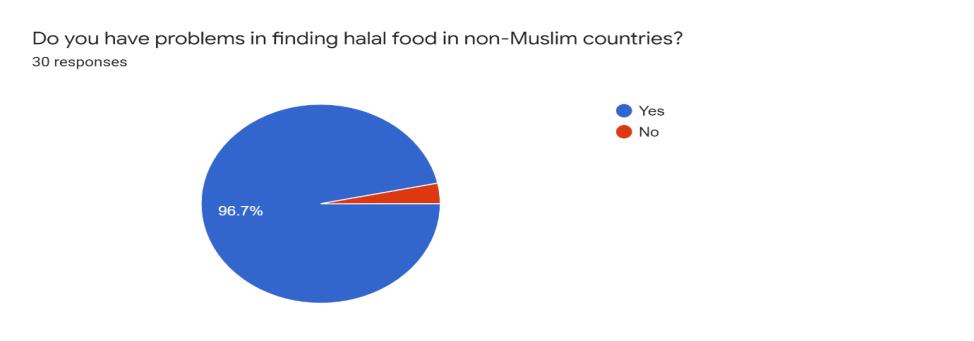
The third question was to ask the users whether the local halal restaurant that they have visited provides online payment. Majority of the people with 83.3% in total said that the local halal restaurants do not provide online payment. While the rest 16.7% of people said otherwise. Pie chart 3 below shows the result for this question. Pie chart 3 below shows the result for question 3.
Pie chart 3: The survey result on the availability of online payment

ISSN 2348-1196 (print)
International Journal of Computer Science and Information Technology Research ISSN 2348-120X (online) Vol. 8, Issue 3, pp: (131-146), Month: July - September 2020, Available at: www.researchpublish.com
The fourth question was to ask the users whether they are familiar with the menus displayed by the restaurant. 90% of people said that they are not familiar with the menus displayed by the restaurant and 10% of them said otherwise. Pie chart 4 below shows the result for question 4.
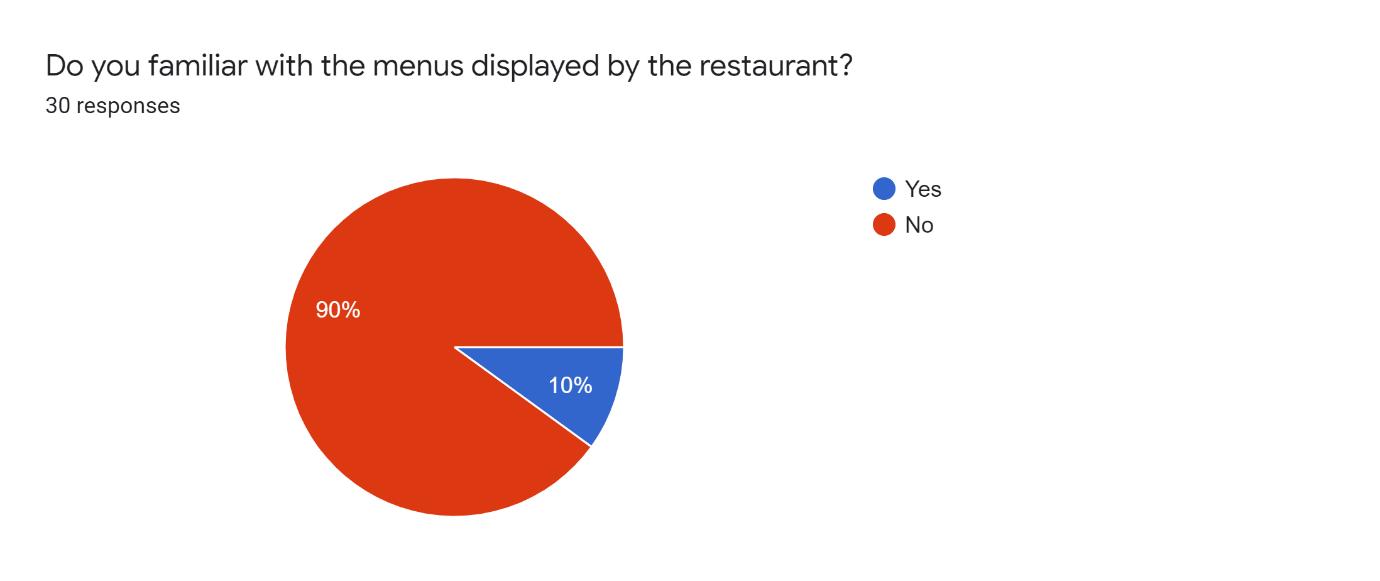
The fifth question was to ask the users whether the restaurant should use biodegradable products for their take away packaging. Results showed that 90% of people said that restaurants should use biodegradable products. Only 10% of them said they should not use biodegradable products. Pie chart 5 below shows the result for question 5.

The sixth question was to ask the users whether they want to use an app that will help them to find halal food in nonMuslim countries. Results showed that all of them want to use it. Pie chart 6 below shows the result for question 6.

ISSN 2348-1196 (print)
International Journal of Computer Science and Information Technology Research ISSN 2348-120X (online) Vol. 8, Issue 3, pp: (131-146), Month: July - September 2020, Available at: www.researchpublish.com
Last but not least, we asked users whether they want to use an app that can perform sadaqah. 100% of people said they want to use it. Pie chart 7 below shows the result for question 7.

Pie chart 7: The survey result on the demand of an app that can perform sadaqah
From this survey, we can conclude that our initial business model canvas is aligned with the customers' needs and demands.
After conducting research and interviews, there is one enhancement to the business model canvas that need to be done. Thus, the business model canvas of HalalFoodies’ conceptual solution is as follows:
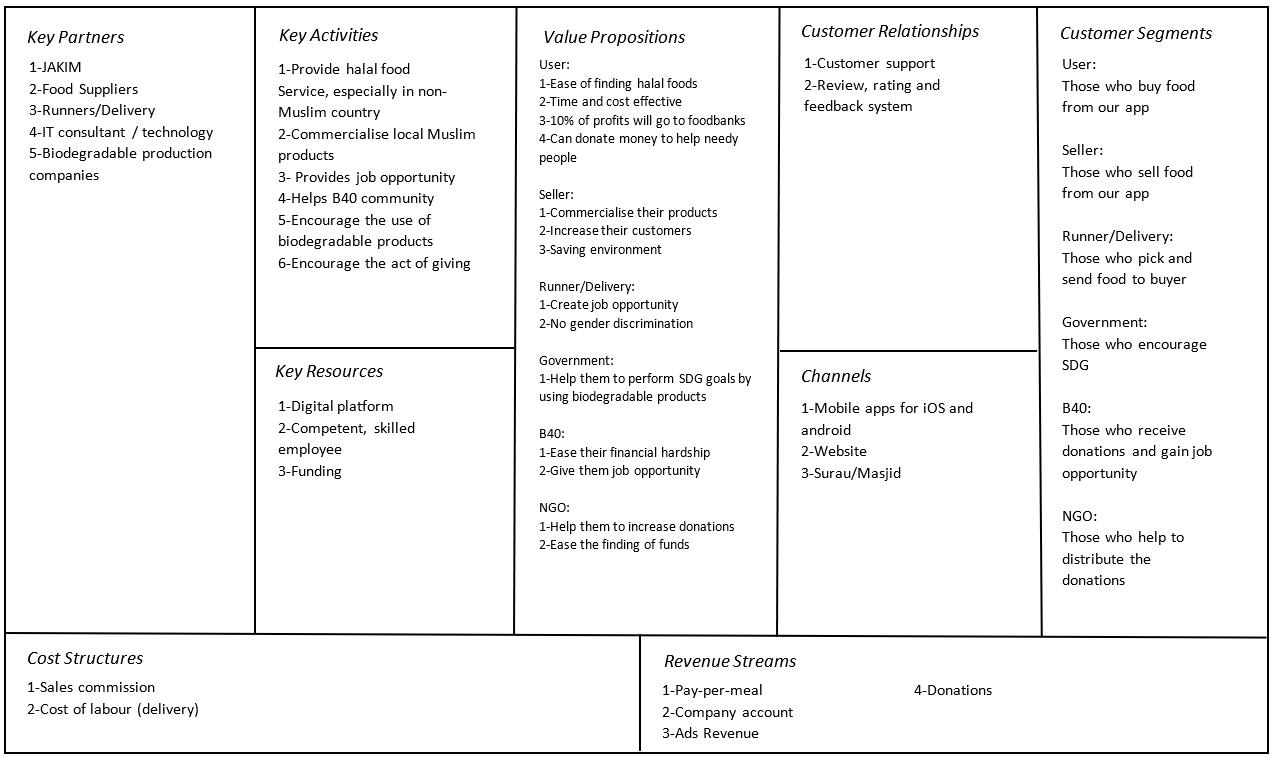
The customer segment section describes the potential customers for HalalFoodies. There are six types of customers for our customer segments which are user, seller, runner, government, B40 people and non-government organization.
ISSN 2348-1196 (print)
International Journal of Computer Science and Information Technology Research ISSN 2348-120X (online) Vol. 8, Issue 3, pp: (131-146), Month: July - September 2020, Available at: www.researchpublish.com
The users for our application are the Muslim travelers who are searching for halal food while traveling to non-Muslim country. Next, the sellers in our customer segments are people who sell halal food in our app. For runners, they are the one who is responsible to pick up and deliver the food for users or buyers. The government is the one who encourages Sustainable Development Goals (SDG). The B40 people are the people who will receive donations from our app and gain job opportunities. Lastly, the Non-Government Organizations (NGOs) are those who help us to distribute the donations.
The value proposition section describes the products and services that are valuable for the customer segments. From user’s perspective, HalalFoodies app can help them to ease the finding of halal food while traveling to non-Muslim country. This will help them also to minimize the time and cost of getting the halal food. In addition, the 10% of the profits that we will gain from customer’s purchases will go to the food banks. The users also have the ability to perform sadaqah through our app to help needy people and perform the sunnah.
From the seller's perspective, HalalFoodies app can help them to commercialize their products, increase the number of their customers and save the environment by using biodegradable products.
From runner’s perspective, job opportunity can be created by working with us as runner and there is no priority given based on gender as we do not support gender discrimination. People with disabilities also can be working with us as runners to increase their income.
From the government's perspective, this will be a platform for them to encourage SDG goals. As our company also supporting the government initiative in promoting SDG goals 1,2,3,5,6,8,10 and 13, we will use biodegradable products for food containers, help needy people through donation, create job opportunity for all gender, create equality and equity in recruiting workers, make sure all the foods are well serve, and help to reduce climate change.
From B40 people’s perspective, HalalFoodies app will help them to ease their financial hardship and give them job opportunities to increase their income by working with us.
From Non-Government Organizations’ perspective, they will gain funding from our app for them to perform their task in helping people in need such as providing clean water to rural areas and providing the necessities for poor people.
Channel section describes the medium that will be used to engage our service or product with customer segments. HalalFoodies can be access through mobile application and websites where the users can find and buy halal foods from the local Muslim restaurants. Moreover, the representative from any Mosque and Network-of-Mosques [9] can help to promote and give guidance on how to use our mobile app.
Customer relationship section describes the medium to strengthen the relationship between customer segments and our company. Therefore, we will provide customer support, customer review, customer rating and feedback system to ensure the quality of our products and services.
Key resource section describes our assets in offering and delivering the service and product for our customer segments. Thus, digital platforms are used to deliver our service or product faster. By hiring competent and skilled employees also will improve the quality of our business. Lastly, creating a funding department is our asset to help B40 people and nongovernment organizations.
Key activity section describes the activities that will be done to run our business. The main activities of our business are to provide halal food service especially in non-Muslim country, to commercialize local Muslim products, provides job opportunity, helps B40 community, encourage the use of biodegradable products and encourage the act of giving.
Key partner section describes the potential collaborators that are needed for our business. The collaboration with JAKIM or halal certification department is needed to ensure the seller who sells their food through our app has halal certificate.
ISSN 2348-1196 (print)
International Journal of Computer Science and Information Technology Research ISSN 2348-120X (online) Vol. 8, Issue 3, pp: (131-146), Month: July - September 2020, Available at: www.researchpublish.com
The collaboration with food suppliers and runners is also needed as the main service of our business is to provide food. Next, consultation with IT consultants will ensure our digital platform up to date. Apart from that, the collaboration with biodegradable production companies is essential to collaborate as we will use biodegradable products for food containers.
Cost structure section describes the in and out cost for our business. The profits that we will gain from the business is from the sales commission. While the cost that we need to pay for our business service is the cost of labor or delivery.
I. Revenue Stream:
Revenue stream section describes the source of income of our company. The incomes of our company are from pay-permeal, ads revenue, donations and deposit of opening company accounts.
In conclusion, these conceptual solutions give benefits to all users especially Muslim users. HalalFoodies provides a medium for users who need of halal food when traveling around the globe. Besides giving benefits to the users, HalalFoodies offers a beneficial platform for the B40s in searching for income and employment. HalalFoodies aims to ease all users despite hiccups that might occur. Its HalalFoodies’s main goal to Muslims users getting halal foods no matter where they are with a proper and flexible system.
Furthermore, the next step to make this into reality is by developing a business plan by applying the V2MOM (Vision, Values, Methods, Obstacles and Measures) Model. Business plan is essential to make a business more efficient. We will develop both mobile applications and web-based applications, as part of future works to help users access the HalalFoodies anytime and anywhere.
[1] Branding, A. (2018, March 23). 3 Target Audiences to Market Your Meal Delivery Service To. Retrieved June 29, 2020, from https://medium.com/@anthembranding_boulder/3-target-audiences-to-market-your-meal-deliveryservice-to-a4f18e353527
[2] Wilkins, Stephen & Butt, Mohsin & Shams, Farshid & Pérez, Andrea. (2019). The acceptance of halal food in nonMuslim countries: Effects of religious identity, national identification, consumer ethnocentrism and consumer cosmopolitanism. Journal of Islamic Marketing. 10.1108/JIMA-11-2017-0132.
[3] Shacklett, M. (2020, May 17). How Technology is Transforming the Food Supply Chain. Retrieved June 29, 2020, from https://www.foodlogistics.com/technology/article/12344804/how-technology-is-transforming-the-food-supplychain
[4] Matulidia, N., Jaafar, H. S., & Bakar, A. N. (2016). The Needs of Systematic Governance for Halal Supply Chain Industry: Issues and Challenges. Journal of Applied Environmental and Biological Sciences, 6, 40-46. Retrieved fromhttps://www.textroad.com/pdf/JAEBS/J.%20Appl.%20Environ.%20Biol.%20Sci.,%206(11S)40-46,%202016. pdf
[5] Fuseini, A., Wotton, S.B., Knowles, T.G. et al. Halal Meat Fraud and Safety Issues in the UK: a Review in the Context of the European Union. Food ethics 1, 127–142 (2017). https://doi.org/10.1007/s41055-017-0009-1
[6] CHOUHOUD, Y. (2020, January 22). The Majority of Muslims Believe Poverty Is the Result of Bad Circumstances, Not Bad Character: ISPU. Retrieved June 29, 2020, from https://www.ispu.org/the-majority-of-muslims-believepoverty-is-the-result-of-bad-circumstances-not-bad-character/
[7] Sheda. (2019, October 17). How To: Business Model Canvas Explained. Retrieved from https://medium.com/seeddigital/how-to-business-model-canvas-explained-ad3676b6fe4a
[8] B2B International. (2020, March 24). What is the Value Proposition Canvas? Retrieved from https://www b2binternational.com/research/methods/faq/what-is-the-value-proposition-canvas/
ISSN 2348-1196 (print)
International Journal of Computer Science and Information Technology Research ISSN 2348-120X (online) Vol. 8, Issue 3, pp: (131-146), Month: July - September 2020, Available at: www.researchpublish.com
[9] Dahlan, A. R. A., Rahmah, A. H. O., Jamaludin, I., & Othman, M. Z. (2016). eHalal4All Program - Promoting Halal Rural Products and Services Globally by Harnessing the Network-of-Mosques (NoM) Capabilities. In Manan, S. K. A., Rahman, F. A., & Sahri, M. (Eds.), Contemporary Issues and Development in the Global Halal Industry. Springer Science+Business Media Singapore
[10] Literature Reviews. (n.d.). Retrieved June 29, 2020, from https://writingcenter.unc.edu/tips-and-tools/literaturereviews/#:~:text=A literature review discusses published,within a certain time period.&text=And depending on the situation,the most pertinent or relevant.
[11] About Us. (2018, May 13). Bungkusit. https://bungkusit.com.my/about-us/
[12] About (2019, June 17). dahMakan. https://dahmakan.com/kuala-lumpur/about
[13] (2020, March 11). Comparison of Malaysia Top 3 Food Delivery Apps /Service. Comparison of Malaysia Top 3 Food Delivery Apps /Service. https://kclau.com/blogging/malaysia-food-delivery-apps-comparison/
[14] Food and grocery delivery in Malaysia | Order online on foodpanda. (2020). FoodPanda. https://www. foodpanda.my/
[15] WILL SHERLIN. (2017, January 30). The Four Lenses of Innovation, with Rowan Gibson. 3Pillar Global. https://www.3pillarglobal.com/insights/four-lenses-innovation-rowan-gibson
[16] World S Top Global Mega Trends To 2020 And Implications to Business Society and Cultures. (2020). World Top Global Trends. https://store.frost.com/world-s-top-global-mega-trends-to-2020-and-implications-to-businesssociety-and-cultures-19880.html
[17] Fisk, P. (2019, December 8). Megatrends 2020-2030 ... what they mean for you and your business, and how to seize the new opportunities for innovation and growth. GeniusWorks. https://www.thegeniusworks.com/2019/12/megatrends-with-mega-impacts-embracing-the-forces-of-change-to-seize-the-best-future-opportunities/
[18] Reu, M. (2019). This is what customers value the most in online food delivery. Retrieved from https://www. deliverect.com/blog/food-delivery/this-is-what-customers-value-the-most-in-online-food-delivery
[19] Oza, H. (n.d.). Eight Benefits of Mobile App Development to Businesses: Hyperlink Infosystem. Retrieved June 29, 2020, from https://www.hyperlinkinfosystem.com/blog/eight-benefits-of-mobile-app-development-to-businesses
[20] Ramanee, R. (n.d.). Crisis forces food companies to leverage online platforms. Retrieved from https://asianagribiz.com/web-feature/crisis-forces-food-companies-to-leverage-online-platforms/
[21] Khurana, A. (2019). Why E-commerce Is Taking the Retail World by Storm. Retrieved from https://www thebalancesmb.com/advantages-of-ecommerce-1141610